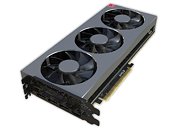Wednesday, January 16th 2019

AMD's Initial Production Run of Radeon VII Just 5,000 Pieces, Company Denies it
More news coming in on AMD's upcoming high-end graphics card, the Radeon VII, with Chinese media reporting that AMD's initial production run for the card is set to ship just 5,000 pieces worldwide. This comes hot on the heels of another report that the Radeon VII won't come in custom-designs by AMD's add-in board (AIB) partners, and that only the reference design will be repackaged and sold by them. What's worse, the source which leaked this production size also revealed that AMD is selling the card below cost-price, i.e., with each card sold, AMD is losing money. This probably explains Wall Street's cold response to the Radeon VII launch, but with a batch size of just 5,000 (roughly $3.5 million in sales at $699 a piece), this card has a negligible impact on AMD's bottom-line.
AMD posted a swift denial to both pieces of news, the size of its production run and the product's profitability. In a statement to MyDrivers, AMD said (translated): "We will not release production figures, but when released on February 7, AMD.com official website and AIB vendor partners will have products on sale, and we expect the supply of Radeon VII to meet the needs of gamers." In short, Radeon VII is shaping up to be the card you'd want to buy if you've sworn a blood-oath never to buy an NVIDIA product, and you need something to play games in 2019 at 4K with.
Sources:
MyDrivers, MyDrivers (2)
AMD posted a swift denial to both pieces of news, the size of its production run and the product's profitability. In a statement to MyDrivers, AMD said (translated): "We will not release production figures, but when released on February 7, AMD.com official website and AIB vendor partners will have products on sale, and we expect the supply of Radeon VII to meet the needs of gamers." In short, Radeon VII is shaping up to be the card you'd want to buy if you've sworn a blood-oath never to buy an NVIDIA product, and you need something to play games in 2019 at 4K with.

124 Comments on AMD's Initial Production Run of Radeon VII Just 5,000 Pieces, Company Denies it
This would be a reasonable and more typical AMD card at 500. Too much vram and compute.:)
We still don't know the actual performance of Radeon VII. How it's supposed to match RTX 2080 with just 25% more performance than Vega 64 remains a mystery to me. And we have to remember that AMD never said explicitly that it was matching RTX 2080, but just showed some cherry-picked benchmarks and the price.
I'm aware that some of these are available for NVIDIA via 3rd party solutions, but NVIDIA doesn't offer them itself and thus shouldn't be counted as features for their cards.It supports DirectML and ROCm based machine learning APIs which can be utilized to do DLSS (or rather, DLSS-like tricks, of course NVIDIA won't give their exact implementation over to others)
It also supports RadeonRays which is RT, it could support DXR given the drivers (it might or might not be fast enough, we won't know until such drivers arrive if ever)Games use more and more compute each day over traditional methods, so of course it helps.
It may function, but does it function as well as dedicated hardware to it? No (likely not). Apologies there as I know I didn't mention HW initially. But yeah, no dedicated hardware to do it likely = worse performance.
If compute mattered as much in games as you say it does, AMD cards would be cleaning the joint up. They aren't.
I'm a betting man... LIKELY. When its used and that flexibility can be leveraged... I'm with ya! When... as it stands they a non player in the gaming RT arena.
When it compute matters enough to make a difference, let me know.
Actually, I don't think things happen overnight. If you read any of my posts in the NV RTX threads, you can see I was one of few voices there who begged for patience on RT tech/implementation. So, like it typical with AMD we have to wait to see if how they do things pan out. I'm still waiting for Vulkan to get traction, for an example. Mantle before it? I realize these are APIs but my point remains. I also don't hedge my bets on the future either. I have always told users both here and my site not to get RTX cards for RT capabilities alone. Buy it on its current performance both with and without. Perhaps this year we will see more titles with it and better implementations. Only time will tell... but regardless of AMD/NV/Intel, etc... I don't hold my breath long. ;)
I don't put any check boxes in future implementations. But to each their own and we will agree to disagree. :)
on-demand.gputechconf.com/siggraph/2018/video/sig1814-2-adrian-tsai-gpu-inferencing-directml-and-directx-12.html around 14:30 or so